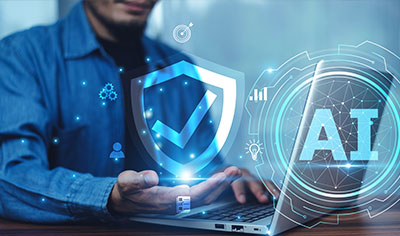Competing in today’s insurance landscape can be tough, especially for small and medium-sized companies facing off against industry giants with better resources. But what these smaller players lack in size, they often make up for in agility, adaptability, and closer customer relationships. These traits give them a unique edge in navigating change and spotting opportunities early. With rapid shifts in technology, customer expectations, and market dynamics, small and medium-sized insurers are well-positioned to turn challenges into growth opportunities—if they play their cards right.
By harnessing their agility and flexibility capabilities, small and medium-sized insurance companies can implement innovative strategies, modernize technological infrastructure, embrace the latest advancements, and cultivate niche markets. In the digital transformation era, the adaptability and responsiveness of smaller businesses could prove instrumental in thriving in the highly dynamic industry. Here are eight practical growth strategies for small and medium-sized insurance businesses to make their mark.
Table of Contents
What Is Insurance Strategy and Why Is It ImportantEffective Ways to Propel Small and Medium-Sized Insurance Business Growth
- 1. Let Go of the Legacy Systems
- 2. Supercharge Personalization
- 3. Become Seamlessly Accessible
- 4. Commit to Social Causes
- 5. Reinvent Through Innovation
- 6. Keep the Eyes on the Price
- 7. Equip Agents with Tech-Powered Tools
- 8. Enhance Customer Education and Engagement
What Is Insurance Strategy and Why Is It Important
An insurance strategy is a structured approach that insurance companies adopt to achieve their long-term business goals, improve operational efficiency, and deliver value to customers. It includes digital transformation, personalized offerings, pricing models, or distribution channels.
A well-defined insurance company strategy ensures that the business stays competitive, adapts to changing market trends, and meets regulatory requirements. It’s essential for small and medium-sized insurers looking to scale sustainably. Organizations can increase profitability, retain customers, and create a resilient business model in a highly dynamic industry by implementing focused growth strategies for insurance companies.
Effective Ways to Propel Small and Medium-Sized Insurance Business Growth
Here are some strategies and practical suggestions for insurance companies aiming to unlock sustainable growth:
1. Let Go of the Legacy Systems
Generative AI (GenAI) is a game-changer in the insurance industry, offering transformative potential across underwriting, claims, and customer service. However, 54% of insurers cite the cost of implementation as a significant challenge to Geni adoption.
As tech-savvy insurers start gaining a clear digital-led competitive edge above their non-technically inclined counterparts, companies are figuring out that legacy insurance systems are holding them back. Small and medium-sized insurance companies have the unique opportunity to kick-start their journey as digitally native organizations.
Insurers are focusing on accelerated underwriting and faster processing of claims to make their product distinction.
So, those who have missed this chance to outperform the competition can still inject digital transformation into their core insurance processes across claims, policy administration, customer experience, and underwriting functions with the right technology solutions.
Modern-day technology tools, digital insurance technology platforms, and their delivery models, including Products-as-a-service (PaaS) and Software-as-a-service (SaaS), are highly flexible. They can integrate and upgrade infrastructure with minimal invasiveness. All insurers need to do is sever the shackles of legacy systems and embrace technology modernization as a core insurance company growth strategy.
Upgrade Your Legacy Systems for Long-Term Success
2. Supercharge Personalization
At a time when personalization has become ubiquitous, small- and medium-sized insurance companies have to offer ‘something special’ to make their offerings stand out. Here’s where differentiation through hyper-personalization enters the picture.
Hyper-personalization uses different technologies like artificial intelligence (AI), advanced data analytics, hyperautomation, and predictive modeling to enable insurers to comprehend what their customers need. This insurance company strategy ensures that rather than pushing a cookie-cutter product like large insurers to customer cohorts, the business curates a one-of-a-kind policy for every customer based on their unique requirements, preferences, lifestyles, life events, and other factors.
Such an approach paves the way for customer-centric growth, which is far more differentiated and sustainable than product-led growth as customer demands begin to carry more weight.
3. Become Seamlessly Accessible
Accessibility is a significant pain point for insurance businesses of all shapes and sizes. Establishing a two-way communication channel is far too difficult for some insurance businesses, especially considering that different customer touchpoints involve different stakeholders across departments or functions. It also hampers the customer experience, which is another bane in itself.
While a multi-channel presence may make insurance businesses more accessible, it still fails to create a sense of seamlessness. The insurer must keep a record of all customer interactions across multiple channels, which helps the customers avoid repeating their problems every time they interact with the insurer.
Against this backdrop, omnichannel communication is a fail-proof solution to break down channel silos and maintain accessibility. Centralizing data and communications through platforms like Salesforce CRM can enable insurance companies to operate as a unit to develop a 360-degree view of their customers, even if they may be demarcated into departments and teams on the inside. Plus, it implements channel-agnostic consistency and contextualization, whether the customer contacts the insurer for a new policy, renewal, claim, or anything else.
4. Commit to Social Causes
Almost 40% of insurance CEOs globally believe that the most significant impact of ESG strategy on the insurance sector will be in building customer relationships and fostering positive brand associations. Meanwhile, 25 percent think the greatest impact will be shaping capital allocation, alliances, and M&A strategy. Such a trend highlights how ESG considerations influence core business areas in the insurance sector. Companies are becoming increasingly mindful of their Environmental, Social, and Governance (ESG) stance.
Insurance companies must do more than just lip service on this front and find ways to align business decisions and actions with core organizational values. The best strategy to achieve this goal is to emphasize investments in green energy and sustainability to promote the green economy. For instance, auto insurers can implement policies to reward carbon offsets and promote electric vehicles. An easier alternative is to associate with or contribute to dedicated agencies that are working to make the world a better place.
5. Reinvent Through Innovation
As the insurance landscape changes, so does the need to transform insurance products and services. Some customers may require a basic vanilla policy, while others may demand something more comprehensive.
As such, businesses must treat insurance as a service rather than a product with a fixed term and premium. With such an insurance business strategy, policies are more flexible and dynamic as they respond to risks and changing conditions. Plus, it would be easier to augment adjacent and closely-related services to increase the value proposition of the coverage.
For example, X has a simple home insurance policy to safeguard property. At the next stage, it can be personalized depending on the location, specification, build, life, etc. In the final tier, X can also be offered risk mitigation services for intrusion and theft prevention using smart devices. Of course, small and medium insurance businesses may have to partner with others to layer their core products.
6. Keep the Eyes on the Price
A research paper demonstrated how even a small rate change amounts to massive customer churn, a testament to the fact that price sensitivity still rules the insurance sector. Such a trend makes more sense as premia decreases due to the elimination of intermediaries with the direct-to-customer (D2C) insurance distribution model.
In such a scenario, AI-based dynamic pricing can help small and medium insurance businesses navigate the choppy waters of increasing rates without affecting customer satisfaction. It uses various tools to price policies based on a range of customer-dependent factors. In this manner, it also imparts personalization to the policy- the result-an impressive profit growth.
7. Equip Agents with Tech-Powered Tools
With today’s quick digital economy, engaging frontline employees—particularly agents and brokers—is essential to successfully implementing an insurance company strategy. Small and medium insurers depend heavily on legacy manual tools or siloed systems that obstruct real-time collaboration, bog down processes, and expand the room for error. By incorporating current, technology-based platforms into the workflows, insurers accelerate the quoting and binding process while improving customer service delivery.
A forward-thinking insurance business strategy should include mobile apps for on-the-go quoting, AI-powered chat assistants for faster communication, and centralized dashboards for managing client portfolios. These enhancements allow agents to spend less time on administration and more on relationship-building. Better still, it enables agents to personalize offerings based on analytics, increasing the relevance of products pitched to potential clients.
As competition intensifies, growth strategies must involve simplifying agent enablement to enhance performance metrics and operational flexibility. By investing in tools that eliminate bottlenecks, insurers are showing they care about innovation and agent success—both of which are cornerstones of any successful insurance business growth strategy.
8. Enhance Customer Education and Engagement
One frequently ignored but effective insurance company growth initiative is enhancing customer education and activation. Most insurance policyholders remain confused regarding their policy details, renewal dates, and claims processes. This disconnection can foster frustration and result in unnecessary churn. Therefore, an intelligent insurance business strategy should aim to empower customers with the information and tools necessary to make informed decisions and feel in control.
Educational material—provided via blogs, webinars, newsletters, or even AI-based chat interfaces—can simplify insurance products and instill confidence. Combining self-service portals and interactive tools like coverage calculators or claim estimators can engage customers proactively. Active customers are more likely to remain loyal, recommend others, and even upgrade their policies.
Insurance companies that successfully establish long-term relationships tend to move beyond transactional engagement. They use customer education as a proactive engagement mechanism. Insurance companies looking to achieve organic growth must place customer understanding and the development of a digital knowledge ecosystem high on the agenda.
Simply put, growth strategies for insurance companies need to incorporate customer education as a pillar to grow sustainably and stand out from the competition.
With the average US loss ratio dropping by 11% points, insurers are in a stronger position to reinvest in strategies that boost customer engagement and long-term growth.
In Conclusion
Even if small and medium-sized insurance companies find themselves in the eye of the storm, it still means that they are not out of action yet. All that’s needed at this juncture is careful planning, smart strategies, and seamless implementation to realize growth. We have discussed a few strategies that have propelled fledgling insurance businesses to the enterprise stage. To recapitulate, the following growth strategies for insurance companies enable them to stay at the helm of all affairs: :
- Switching to modern, digital solutions
- Adopting hyper-personalization
- Establishing an omni-channel presence
- Enacting corporate social responsibility
- Reimagining insurance products and services
- Enforcing dynamic pricing
- Equipping agents with advanced tools
- Educating and engaging customers
The eight insurance business strategies discussed above help insurers weather the storm while also staying customer-focused, growth-oriented, and profitable.
Case in Focus
A multi-line insurer had an existing home-grown legacy system. However, managing multiple transactions on the legacy system was a costly, complex, and time-taking affair. It also created data silos and contributed to operational inefficiencies. We helped the insurer accelerate its technology modernization journey. As a result, the insurer was able to reduce the operational cost of its business unit by 20%. For more details, refer to the complete case study.







